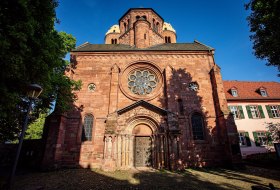
searchMenu



Experience "Ingelheim in Roman times" via augmented reality The Museum bei der Kaiserpfalz has developed a new mobile app that allows users to immerse themselves in the world of antiquity. The digital application focuses on three life-size Roman statues that were originally part of a monumental, colourfully painted tomb. This funerary monument is embedded as a digital reconstruction in the Roman settlement landscape of the 1st century AD and can be recreated astonishingly realistically with a 360° panorama as augmented reality. …

The building used today as the Protestant parish hall is an example of the traditional quarry stone construction typical of the region. It was built in 1828 as a Protestant school with a teacher's flat, stable and barn, after the old building at Schulgasse 6 was no longer sufficient. In 1827, the Grand Ducal Hessian government introduced compulsory schooling from the age of six to fourteen for girls and boys. Until 1842, children in the countryside only attended school from November to Easter. During the warmer seasons, they helped out on…

The monastery and convent of St. Paulus, built from 1002 onwards, is located in the centre of Worms and is a place of peace and quiet in this lively city. The collegiate church was originally built as a three-nave Romanesque pillar basilica, and the stone dome helmets of the two pagan towers give the church its special appearance. Unlike other collegiate churches, the choir is closed on five sides in good late Romanesque forms. The west building has an octagonal dome (13th century) and is flanked by two older stone-covered round towers…

Former Lutheran church, built 1738-42 in rural baroque style - tower 1930, three-sided hall, stucco ceiling and furnishings from the time of construction, "pneumatic cone chest organ" from the workshop Förster & Nikolaus Lich/Upper Hesse from 1915, also called winter church, since the installation of a church heating system at the end of the 19th century. Text Signposting with kind permission of the Orsgemeinde Flörsheim-Dalsheim This location is part of an audiovisual route and offers the possibility to watch/listen to…

The red hillside is a wine growing area with special optics between Nierstein and Nackenheim. The former formation emerged over 280 million years ago because of a collapse of the rhine ditch between the basin of Mainz and the upper rhine ditch. Another special feature is the red ground which was also determining for the name. The colouring happened because of embedded iron compounds which emerged under the subtropic climate of another era. The substance of the ground is consists of clay and sandstone and in combination with the climate…

The vantage point Johannisberger Türmchen on the hiking trail "Rabenschule" between Gau-Algesheim and Jackobsberg Monastery offers fascination in its purest form with its far-reaching view. The rustling of the vine leaves in the wind and the singing of the birds at the Johannisberger Türmchen accompany the view of the Rhine valley, the Rheingau, the Niederwald Monument, the Rochusberg near Bingen and, in good weather, as far as the Taunus.

Digital tour, developed in a cooperation between the Research Center Kaiserpfalz Ingelheim and the Museum bei der Kaiserpfalz, which you can view on YouTube . It is led by Miriam Maslowski, historian and art historian (Museum bei der Kaiserpfalz). She introduces a number of outstanding women personalities of the High Middle Ages: They were all rulers who had an amazing wealth of power and even directed the fortunes of the Holy Roman Empire for a certain time. There is also evidence that all five empresses stayed in the imperial palace in…